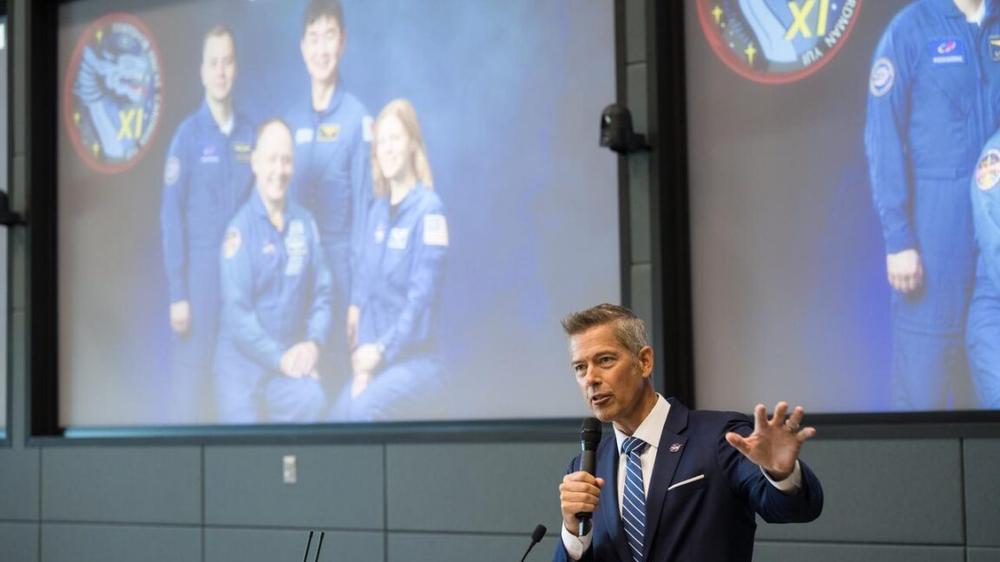NASA acting administrator Sean Duffy made two television appearances on Monday morning in which he shook up the space agency’s plans to return humans to the Moon.
Speaking on Fox News, where the secretary of transportation frequently appears in his acting role as NASA chief, Duffy said SpaceX has fallen behind in its efforts to develop the Starship vehicle as a lunar lander. Duffy also indirectly acknowledged that NASA’s projected target of a 2027 crewed lunar landing is no longer achievable. Accordingly, he said he intended to expand the competition to develop a lander capable of carrying humans down to the Moon from lunar orbit and back.
“They’re behind schedule, and so the President wants to make sure we beat the Chinese,” Duffy said of SpaceX. “He wants to get there in his term. So I’m in the process of opening that contract up. I think we’ll see companies like Blue [Origin] get involved, and maybe others. We’re going to have a space race in regard to American companies competing to see who can actually lead us back to the Moon first.”
There are a couple of significant takeaways from this interview. First is the public acknowledgement by a senior NASA official that the space agency’s current timeline of a 2027 landing is completely untenable. And secondly, the timing of Duffy’s public appearances on Monday morning seems tailored to influence a fierce, behind-the-scenes battle to hold onto the NASA leadership position.
“Opening that contract up”
SpaceX won a contract from NASA, worth $2.9 billion, in April 2021 to develop and modify its ambitious Starship rocket to serve as a “human landing system” (HLS). This rocket would work in concert with NASA’s Space Launch System and Orion spacecraft to get humans from Earth, to the lunar surface, and back. Two years later Blue Origin, a rocket company founded by Jeff Bezos, won a second contract, worth $3.4 billion to develop a second lander.
Duffy is correct that SpaceX is moving slower than anticipated. The company must still cross several technical hurdles before it can provide landing services to NASA. In their funded contracts for reusable landers, SpaceX and Blue Origin must refuel their vehicles in low-Earth orbit, something which has never been done before on a large scale.
When Duffy says “companies like Blue” may get involved, he is not referring to the existing contract, in which Blue Origin will not deliver a ready-to-go lunar lander until the 2030s. Rather he is almost certainly referring to a plan developed by Blue Origin that uses multiple Mk 1 landers, a smaller vehicle originally designed for cargo only. Ars reported on this new lunar architecture three weeks ago, which company engineers have been quietly developing. This plan would not require in-space refueling, and the Mk 1 vehicle is nearing its debut flight early next year.
Duffy also cites “maybe others” getting involved. This refers to a third option. In recent weeks, officials from traditional space companies have been telling Duffy and the chief of staff at the Department of Transportation, Pete Meachum, that they can build an Apollo Lunar Module-like lander within 30 months. Amit Kshatriya, NASA’s associate administrator, favors this government-led approach, sources said.
On Monday, in a statement to Ars, a Lockheed Martin official confirmed that the company was ready if NASA called upon them.
“Throughout this year, Lockheed Martin has been performing significant technical and programmatic analysis for human lunar landers that would provide options to NASA for a safe solution to return humans to the Moon as quickly as possible,” said Bob Behnken, vice president of Exploration and Technology Strategy at Lockheed Martin Space. “We have been working with a cross-industry team of companies and together we are looking forward to addressing Secretary Duffy’s request to meet our country’s lunar objectives.”
NASA would not easily be able to rip up its existing HLS contracts with SpaceX and Blue Origin, as especially with the former much of the funding has already been awarded for milestone payments. Rather, Duffy would likely have to find new funding from Congress. And it would not be cheap. This NASA analysis, from 2017, estimates that a cost-plus, sole-source lunar lander would cost $20 billion to $30 billion, or nearly 10 times what NASA awarded to SpaceX in 2021.
SpaceX founder Elon Musk, responding to Duffy’s comments, seemed to relish the challenge posed by industry competitors.
“SpaceX is moving like lightning compared to the rest of the space industry,” Musk said on the social media site he owns, X. “Moreover, Starship will end up doing the whole Moon mission. Mark my words.”
The timing
Duffy’s remarks on television on Monday morning, although significant for the broader space community, also seemed intended for an audience of one—President Trump.
The president appointed Duffy, already leading the Department of Transportation, to lead NASA on an interim basis in July. This came six weeks after the president rescinded his nomination of billionaire and private astronaut Jared Isaacman, for political reasons, to lead the space agency.
Trump was under the impression that Duffy would use this time to shore up NASA’s leadership while also looking for a permanent chief of the space agency. However, Duffy appears to have not paid more than lip service to finding a successor.
Since late summer there has been a groundswell of support for Isaacman in the White House, and among some members of Congress. The billionaire has met with Trump several times, both at the White House and Mar-a-Lago, and sources report that the two have a good rapport. There has been some momentum toward the president re-nominating Isaacman, with Trump potentially making a decision soon. Duffy’s TV appearances on Monday morning appear to be part of an effort to forestall this momentum by showing Trump he is actively working toward a lunar landing during his second term, which ends in January 2029.
Duffy has appeared to enjoy the limelight that comes with leading NASA. In the future, one source said, “Duffy wants to be president.” The NASA position has afforded him greater visibility, including television appearances, to expand his profile in a positive way. “He doesn’t want to give up the job,” the source added.
A Republican advisor to the White House told Ars that it is good that Duffy has moved beyond his rhetoric about NASA beating China to the Moon and to look for creative tactics to land there. But, this person said, the mandate from the Trump administration is to dominate the emerging commercial space industry, not hand out large cost-plus contracts.
“Duffy hasn’t implemented any of the strategic reforms of Artemis that the president proposed this spring,” the Republican source said. “He has the perfect opportunity during the current shutdown, but there is no sign of any real reform under his leadership. Instead, Duffy is being co-opted by the deep state at NASA.”

 Apple will let users roll back the Liquid Glass look with new ‘tinted’ option
Apple will let users roll back the Liquid Glass look with new ‘tinted’ option